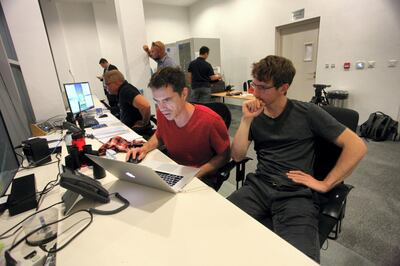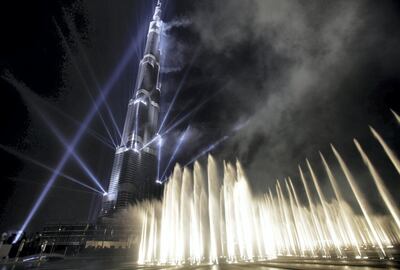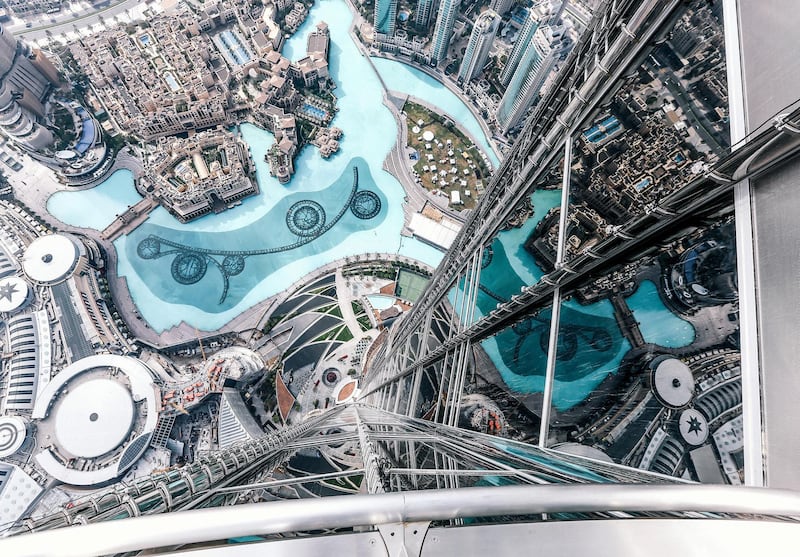It would be a brave promoter who envisaged staging an eclectic concert featuring such diverse talents as British singer-songwriter Adele, Italian opera tenor Luciano Pavarotti, US pop star Lionel Richie, French chanteuse Édith Piaf, Emirati singer Eida Al Menhali, Czech classical composer Antonín Dvořák and K-pop boy band EXO.
Yet in the nine years Dubai’s world-famous dancing fountain has been drawing vast crowds, all these and more have been called upon to supply the soundtrack for what has become the single most popular tourist attraction in a city not short of spectacles or experiences.
The Dubai Fountain playlist is not a cynical effort to ingratiate the city with each and every tourist or expat – the sheer diversity of visitors to Dubai would make that an impossible task. Instead, it is a tribute to the careful curation behind the show that every one of the 48-plus pieces of music that has been chosen for the fountains to dance to over the past decade has never seemed anything but perfectly at home, chosen to complement both the fountain and the city.

On average, there are 13 Dubai Fountain shows daily (at 30 minute intervals) - they run at 1pm and 1.30pm and 6pm to 11pm daily (and 1.30pm to 2pm on Fridays).
The frequency means that there can be diversity, as Ahmad Al Matrooshi, managing director Emaar properties explains: "This means we can roll out a significant selection of songs, which appeal to the international profile of our visitors at Downtown Dubai... The UAE National Anthem is played every day.”
How songs get chosen
Peter Kopik, head of choreography for Los Angeles-based company WET, which designed and operates the fountain, says he and his colleagues take responsibility for ensuring its “dignity” is preserved.

“Dubai is very strongly trying to market itself as an international destination and the Fountain, which welcomes so many visitors to Dubai, is a major part of that,” he says. “We need to make sure that this fountain retains its dignity and that the music chosen for it doesn’t, for example, make a joke out of it. Yes, we can be lighthearted once in a while, but we always have to be careful to make sure we aren’t doing any damage to this iconic attraction.”
The choice of music played is tightly controlled. Some is chosen by the client, property developer Emaar, which submits ideas to WET to see which work best for choreography. At other times, WET chooses music and submits a shortlist to Emaar. “The client is very flexible,” says Kopik.
Organisers of special events must also have their music choices vetted by WET.
One song that was rejected
“We have to make sure the music fits the fountain, not only whether it’s good for choreographing but also whether the music respects the fountain," adds Kopik. "We wouldn’t want to have something cheesy or that would degrade the seriousness of the fountain, in which case we reject it.”
One song that failed to pass muster was Gangnam Style, the 2012 international hit by South Korean musician Psy. "We were asked to put it on the fountain and I said, okay, guys, it is going to be a laughing stock. It would be like the Queen of England singing this song – it's just not appropriate."
Pop still flies, however
Not that the fountain automatically turns up it nose at K-pop, or wildly successful pop in general.
The South Korean-Chinese band EXO, hugely popular in Asia, are the latest artists whose music has been chosen to soundtrack the Dubai Fountain.
The band, which has had a major hit with the song Power, was in Dubai last weekfor the inaugural performance of the number as the latest addition to the fountain playlist.
A cultural collage
Staging a show with music that tries to strike a chord with visitors from around the world sounds like a recipe for creative disaster. But in Dubai, which has become one of the world’s leading commercial and cultural entrepôts, the skilfully chosen repertoire pulls off the tightrope act of tapping into diverse cultural roots without ever losing touch with the region’s Arabic heritage.
One minute mischievous and fun-loving, the next thoughtful and soulful, and then dramatic and moving, the fountain rarely fails to delight.
And where else but at the crossroads of the modern world to showcase the musical diversity of that world? The music that has moved millions since The Dubai Fountain opened in May 2009, in person and through countless visitors’ well-watched YouTube videos, is the soundtrack not only to a vibrant and cosmopolitan city, but to an age of globalisation with which an ever increasing proportion of the world’s population identifies.
Culturally transcending, the music of the fountain somehow evokes the uplifting prospect of a world in which diversity of language, belief and culture acts not as a barrier, but as a bridge to understanding. Where else might an Anglo-Saxon tourist from north America or Europe hear, let alone be moved by, traditional Arabic music, or their counterpart from China or India be stirred by western opera?
Yet while tapping into diverse cultural roots, the fountain never loses touch with the city's own heritage, and showcases a variety of Arabic music. In January 2010 the newly composed Emirati song, Inshed An Aldar (Ask about home), "inspired by the festive spirit of dancing and happiness, and reflecting the UAE's proud musical traditions", was added to the repertoire in celebration of the inauguration of Burj Khalifa.
And the overall impact of this cultural collage is nothing less than magical. To stand amid the throng that gathers daily to witness the spectacle at the foot of the world's tallest building, the hairs on the back of one's neck stirring to the haunting strains of Dvořák's New World Symphony or the infectious rhythms of Sama Dubai, written and performed by Emirati singer Mehad Hamad as a tribute to Sheikh Mohammed, is to feel, in Kopik's words, "like a global citizen", communing with likeminded souls in the world's town square.
“For me it’s the most amazing thing just to go there and watch people’s reactions,” he says, “to listen to what they say, see how they engage with and how, once in a while, they are mesmerised or completely taken aback by the power of this fountain.”
Sometimes, he admits, “the hairs stand up even on the back of my neck, yes. But the biggest reward for me is seeing somebody else have that same reaction, to a moment in their life that they are going to take away and perhaps never forget".

The sentiment echoes the ambition of WET's founder and CEO Mark Fuller. When testing of the Dubai Fountain began in March 2009, he said the intention was “to create an unparalleled experience that brings people together through a shared experience of light, sound and emotion”.
Dubai’s fountain, capable of shooting water up to 152 metres in the air, is the largest of its type in the world. But “it’s not at all about the size”, as Fuller said in a 2015 interview. “It’s about seeing people enchanted … I like making people feel more glad to be alive.”
How long does it take to create a new piece?
Kopik and his team of half a dozen US-based choreographers have faced several challenges setting the fountains to music, a process that starts on a computer simulation before the team flies to Dubai to download the result to the fountain for fine-tuning, and can take anything between two and four weeks from start to finish.
Choreographing Arabic music presents a particular challenge, says Kopik, partly because of the “significant difference between western and Middle Eastern music and dance traditions, which we have to take into consideration. We had a lot to learn – in fact at the beginning we sought the help of the Dubai Culture and Arts Authority.”
The other consideration, he says, is attempting to reflect the geometric patterns found throughout Islamic culture.
“All you see in a mosque are the gorgeous and mind-bogglingly intricate geometrical patterns, and we try to echo this on the fountain, by creating patterns that reflect the culture while still following the music and keeping the public engaged.”
It is, he says, “a challenge to come up with new patterns every time you do Arabic choreography".
But come up with them they do. In the spectacular setting of the fountain Sama Dubai, which opens every day's performance, has become the joyously upbeat theme music for the city itself.
The challenge of Michael Jackson's Thriller
Kopik says the most challenging piece of music he has choreographed for Dubai was Michael Jackson's Thriller. "The beat remains the same throughout and what everybody is listening to is the lyrics, and of course they are remembering the video, which is really where the story is. So I tried to pay homage to the video and borrow certain elements of that dance and represent it for the fountain."
It took him five weeks to get it right – the longest he has ever spent choreographing a piece – and the result was truly amazing. Like so many of the Fountain performances, it can be found on YouTube, garnering millions of views and rave reviews and, in the process, helping to transmit Dubai’s message to the world.
The choreographer's favourite piece
Kopik's favourite routine? "One of the earliest I did, Time to Say Goodbye, by Andrea Bocelli and Sarah Brightman. I thought that was a very strong piece."
Fans agree. Just one of many YouTube videos, filmed in 2009, has attracted well over 3 million views, and a random selection of comments demonstrates the success of the project – “One of the wonders of the world”, “The most amazing tourist attraction”, “Simply magical”, “Awesome”, “Fantastic”, “I love the UAE” and, a frequent and poignant theme, “It is my dream to one day go there”.
For residents who host friends and family visiting Dubai the fountain has become the number-one must-see destination in any tour of the city’s delights, and one that never seems to lose its appeal – even the most jaded expat can easily be persuaded to make their umpteenth visit.
As one western resident commented under one YouTube video of a fountain performance, “I watch this every night… love it, love it: makes my day”.
From Edith Piaf's La Vie En Rose and an instrumental version of Lou Reed's Walk on The Wild Side, to Twlht Ana Lsotak by Emirati singer Eida Al Menhali and Ishy Bilady, the UAE National Anthem, written in 1971 by Egyptian singer and composer Mohammed Abdel Wahab – the Fountain's sonic kaleidoscope of musical influences, traditional and modern, western and Eastern, has become the soundtrack to one of the 21st century's most exciting cities.
Fast facts
- Has over 22,000 gallons of water in the air at any one time
- Is 274 metres in length
- Sprays 152 metres into the air - the height of a 50-storey building
- There are 6,600 WET Superlights
- 25 colour projectors create a visual spectrum of over 1,000 different water expressions
- 50 colour projectors provide a full spectrum of colour with a total output of 1.5 million lumens
- Beams of light can be seen from more than 32 kilometres away
Performance list includes...
- Sama Dubai, a tribute to Dubai's ruler Sheikh Mohammed, which is usually the first show of the day
- Baba Yetu (a Grammy award-winning song in Swahili from the Civilization IV video game soundtrack) by Christopher Tin
- Shik Shak Shok (an Arab dance song) by Hassan Abou El Seoud
- Inshed An Aldar ("Ask About Home"), an Emirati song written for the inauguration of the Burj Khalifa on 4 January 2010[4]
- Con Te Partirò (Time to Say Goodbye) by Andrea Bocelli and Sarah Brightman
- Dhoom Thana (a Hindi song) by Vishal and Shekhar
- Bassbor Al Fourgakom by Emirati artist Hussain Al Jasmi
- I Will Always Love You by Whitney Houston
- All Night Long by Lionel Richie
- The Magnificent Seven (main theme from the film The Magnificent Seven) by The City of Prague Philharmonic Orchestra
- Thriller by Michael Jackson
- Ishtar Poetry by Furat Qaddouri
- O Mio Babbino Caro by Dame Kiri Te Kanawa
- Enta Omri by Hossam Ramzy
- The Prayer by Celine Dion and Andrea Bocelli
- Lana Allah by Mohammed Abdu
- Ezel (theme song from the TV series of the same name) by Toygar Isikli
- Flying Drum by Vertical Orchestra
- Butterfly Lovers' Violin Concerto by Lu Siqing
- Ain't No Mountain High Enough (remix by Paul Epworth, presented by DHL) by Vula Malinga
- Ishy Bilady, The UAE National Anthem
- Wen Bie by Jacky Cheung
- Hello Tomorrow (composed by Christopher Tin) by Royal Philharmonic Orchestra
- The Centre of Now by Barbara Szymanska
- Walk On The Wild Side (Instrumental)
- Turandot/Act 3-Nessun Dorma by Luciano Pavarotti and John Alldis Choir
- Mission Impossible (remix) by The Lounge Crew
- From The New World * IV by Herbert von karajan
- Aa Bali Habibi by Elissa
- Hero (Spanish version) by Enrique Iglesias
- La Vie En Rose by Édith Piaf
- Skyfall by Adele
- Power by EXO





